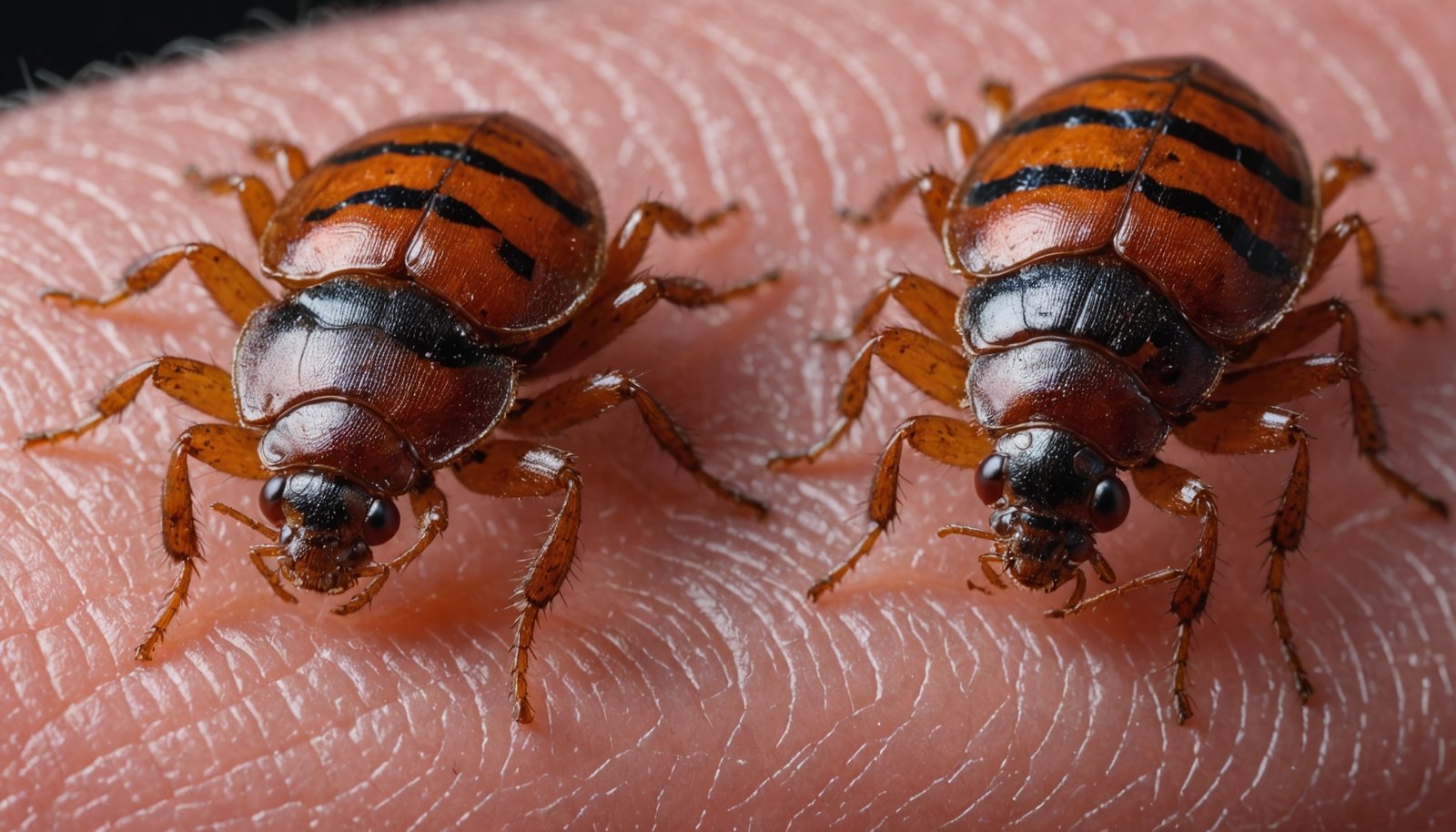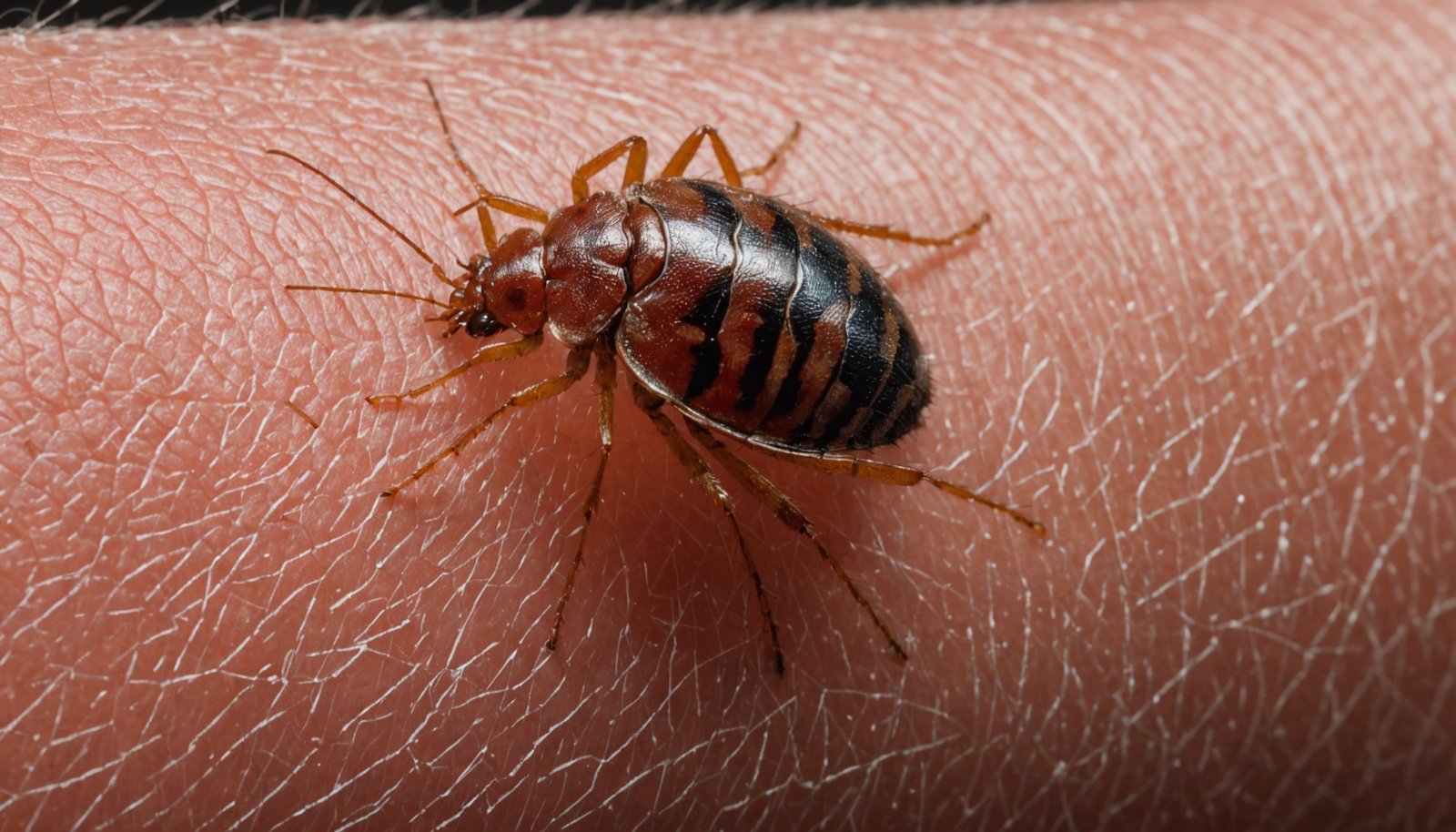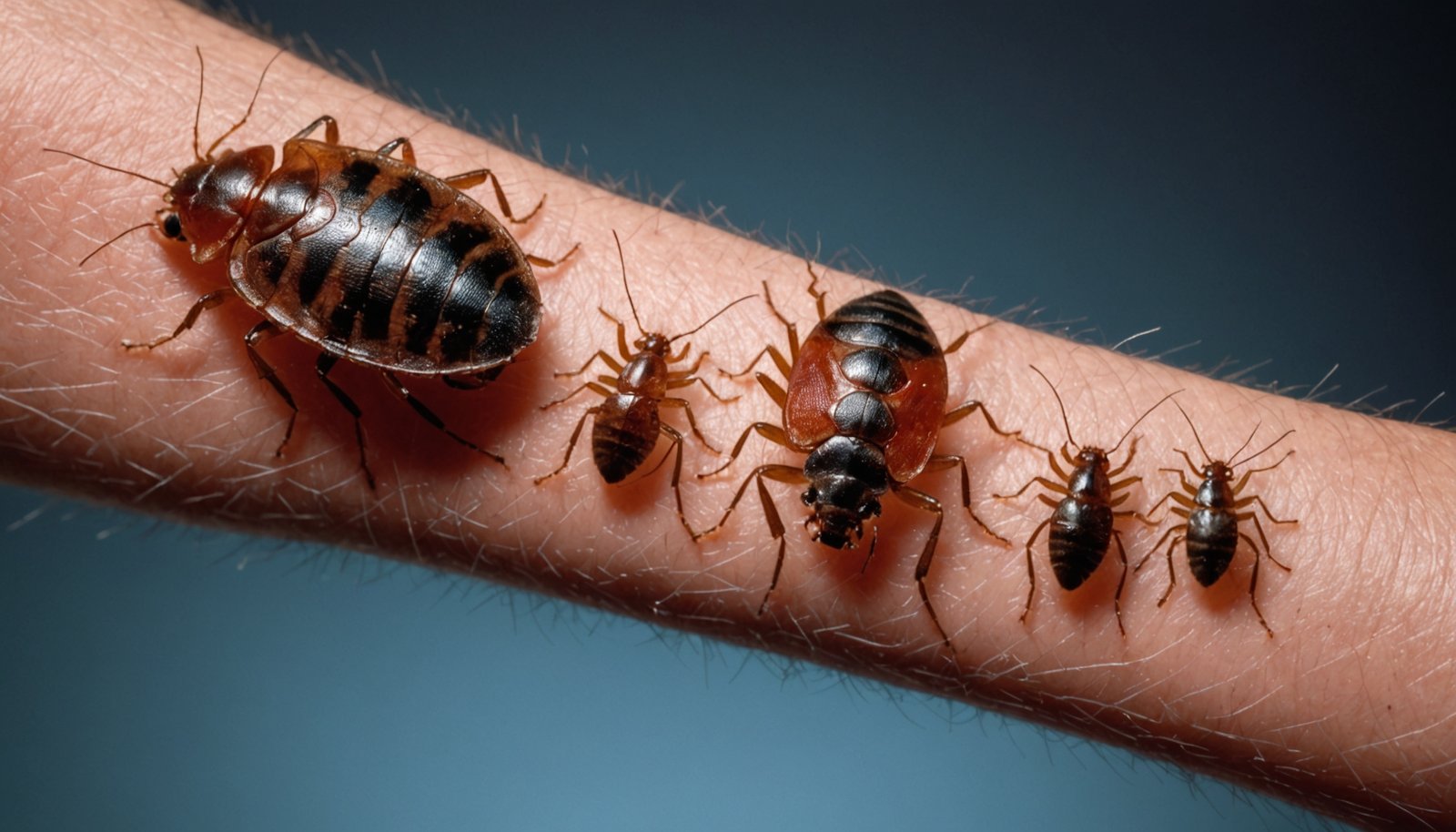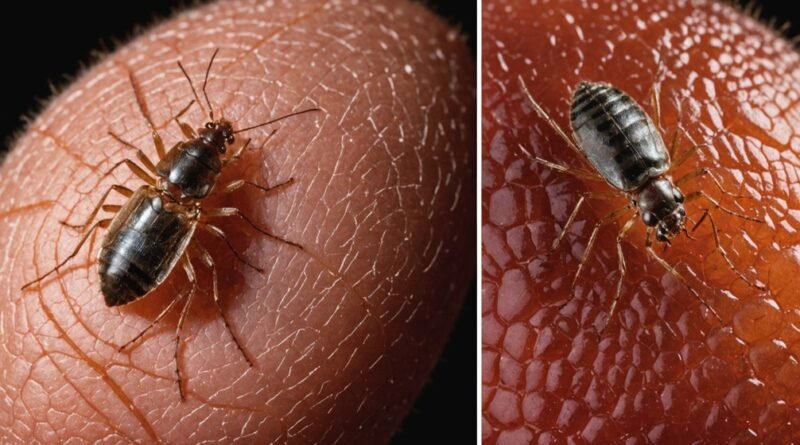Bed Bug Bites vs. Mosquito Bites: Key Differences and Pictures
You can tell bed bug bites from mosquito bites by look and pattern. Bed bugs leave small, firm, flat-topped red bumps with defined edges, often in neat lines or tight clusters on exposed skin. Mosquito bites are puffier, dome-shaped welts with softer borders, appear fast, and scatter randomly. Bed bug itch builds slowly and can worsen over days; mosquito itch is immediate. Clean, cool, and treat with hydrocortisone or antihistamines. See photos, prevention tips, and when to seek care next.
Key Takeaways
- Bed bug bites are small, firm, flat-topped red papules; mosquito bites are puffier, dome-shaped welts with softer borders.
- Bed bug bites often align in linear “breakfast-lunch-dinner” clusters; mosquito bites appear as random, scattered single welts.
- Bed bug itch builds slowly and can worsen over time; mosquito bites itch immediately and welts flatten sooner.
- Bed bug bites occur on exposed areas during sleep; mosquito bites can appear on both exposed and covered areas.
- Treat both with cleansing and cold compresses; use hydrocortisone or antihistamines, and prevent with bed encasements vs. repellents and removing standing water.
Visual Differences: Size, Shape, and Color

Two quick clues set bed bug bites apart from mosquito bites: pattern and presentation. Focus on how each bite looks.
Bed bug bites are usually small, firm, and flat-topped. They’re often pink to red with a defined edge and a lighter center. You might see slight swelling, but it’s modest and uniform.
Mosquito bites, by contrast, tend to be puffier, dome-shaped welts with softer borders and more obvious swelling.
Color helps, too. Bed bug bites often stay a consistent pink-red, sometimes deepening with irritation. Mosquito bites can shift quickly from pale to bright red, then fade as swelling subsides.
Size differs: bed bug bites are usually pea-sized or smaller, while mosquito welts can expand noticeably.
Examine edges, height, and color change to tell them apart.
Patterns and Clustering of Bites

You’ll often see bed bug bites form linear “breakfast-lunch-dinner” lines that trace where the insect fed.
Mosquito bites usually appear as random single swollen welts without a clear pattern.
Bed bugs can also leave tight clusters on exposed areas like arms, legs, and neck, especially after a night’s sleep.
Linear “Breakfast-Lunch-Dinner” Lines
Although both pests can leave clusters, bed bugs often create a telltale linear pattern—nicknamed “breakfast, lunch, and dinner”—as they feed along a short path.
You’ll typically see three or more small, red, itchy bumps in a row or gentle arc, spaced a few millimeters apart. This pattern reflects a single bug probing for a good blood vessel or multiple bugs feeding sequentially along exposed skin.
Look for lines on areas that contact the mattress edge or sheet seams—forearms, shoulders, neck, waist, and lower legs. The grouped bites usually share a similar size and stage, appearing overnight and intensifying with morning itching.
While lines can curve slightly, they stay organized compared with scattered groupings. When you notice repeated linear trios, suspect bed bugs and inspect bedding, seams, and nearby crevices promptly.
Random Single Swollen Welts
A lone, puffy welt that appears out of nowhere and doesn’t form a tidy line points more toward a mosquito than a bed bug. You’ll often notice one isolated bump that rises quickly, feels warm, and itches intensely. Mosquito bites tend to be random, singular, and inconsistent in size, appearing after brief outdoor exposure or when a window was left open. Bed bug bites, by contrast, more commonly show patterns, not one-off surprises.
Use this quick comparison when you spot a solo welt:
| Feature | More Suggestive Of |
|---|---|
| One isolated, swollen bump | Mosquito |
| Sudden onset after being outdoors | Mosquito |
| No clear pattern or grouping | Mosquito |
| Delayed swelling, multiple areas over time | Not a mosquito |
Document timing, location, and any new entry points to confirm.
Tight Clusters on Exposed Areas
When bites appear in tight clusters on exposed skin—think forearms, legs, neck, or face—they point strongly toward bed bugs rather than mosquitoes.
Bed bugs often feed in lines or zigzags, creating a “breakfast, lunch, and dinner” pattern: three to five bites spaced a few millimeters apart. You’ll usually notice them after sleep or rest, especially along edges where skin meets sheets.
Mosquito bites tend to be scattered, single welts on mixed exposed and covered areas from outdoor activity. They don’t typically form tight, linear groupings. If you’re seeing clusters that follow a seam of pajamas, a sock line, or the jawline, suspect bed bugs.
Check for other clues: tiny blood dots on sheets, dark fecal specks near mattress seams, shed skins, or a sweet, musty odor.
Timing and Where Bites Show Up on the Body

Because timing and placement offer strong clues, pay attention to when bites appear and where they cluster.
Bed bugs feed while you sleep, so you’ll often notice new marks after waking, especially following nights in the same bed. They favor skin pressed against sheets: forearms, shoulders, neck, lower back, and along waistbands or sock lines.
Mosquitoes strike from dusk through evening outdoors and leave scattered bites on exposed limbs, often one-off rather than in a tidy line.
- Morning reveal: fresh bites after a full night’s rest point more to bed bugs than mosquitoes.
- Linear “breakfast, lunch, dinner” tracks along edges of clothing suggest bed bugs.
- Random, solo welts after evening activities lean mosquito.
- Travel clues: bites after hotel stays, especially recurring nightly, raise bed bug suspicion.
Symptoms, Itch, and Allergic Reactions
Noticing where and when bites appear sets the scene; how they feel and look can separate the culprits. Bed bug bites often produce small, firm, red papules with a slow-building itch that peaks hours later. You may notice burning or tenderness and a localized swelling that lingers for days.
Bed bug bites: small, firm red papules with slow-building itch, burning, and swelling that lingers for days.
Mosquito bites usually welt quickly, itch fast, and flatten sooner as the histamine response settles.
Bed bugs can trigger delayed hypersensitivity; your reactions might worsen after repeated exposures, leading to larger, more inflamed clusters and occasional hives.
Mosquito saliva more commonly causes immediate itch, with individual welts rather than grouped lesions.
Watch for warning signs: widespread hives, facial swelling, trouble breathing, or dizziness require urgent care.
Otherwise, manage itch with cold compresses, oral antihistamines, or topical steroids as directed.
Photos and Identification Tips
Photos can sharpen your eye for patterns that set bed bug bites apart from mosquito welts. Study close-ups to spot clues: bed bug bites often cluster in straight or zigzag “breakfast, lunch, dinner” lines, while mosquito bites appear as isolated, puffy bumps.
Look at lighting and angles that show color—bed bug bites skew pink to red with a darker center; mosquito welts can look paler with a raised, uniform dome.
- Check distribution: bed bugs target exposed skin that touched bedding—arms, shoulders, neck, face; mosquitoes bite anywhere, especially ankles and outdoor-exposed areas.
- Note timing: bed bug marks commonly show up overnight.
- Compare size: bed bug bites stay small; mosquito welts can balloon.
- Inspect surroundings: photograph sheets, mattress seams, and headboards for fecal spots or shed skins.
Treatment, Relief, and Prevention Steps
You’ll start with immediate bite care: wash gently, apply a cold compress, and avoid scratching.
For itch relief, use topical hydrocortisone, oral antihistamines, or soothing agents like calamine or colloidal oatmeal.
To prevent future bites, seal entry points, use bed encasements or screens, eliminate standing water, and apply EPA-registered repellents as needed.
Immediate Bite Care
Although both bites can look similar, act quickly to clean the area with mild soap and water, then apply a cold compress for 10–15 minutes to reduce swelling and itch.
Pat dry and leave the skin uncovered to breathe. Avoid scratching so you don’t break the skin or invite infection. If you’ve been outdoors, check nearby skin and clothing for more bites or insects, then move indoors.
- 1. Disinfect: After washing, you can dab a small amount of antiseptic (like chlorhexidine) to lower infection risk.
- 2. Protect: Cover open or scratched spots with a thin adhesive bandage to prevent friction and contamination.
- 3. Monitor: Note timing, number, and pattern of bites (clusters suggest bed bugs; singles are often mosquitoes).
- 4. Prevent: Change into clean clothes, shake out bedding, and run a quick body check before resting.
Itch Relief Options
Even after you clean the area, target the itch quickly to stop the scratch–swelling cycle. Apply a cold compress for 10–15 minutes to numb nerves and reduce puffiness. Dab 1% hydrocortisone cream or a calamine lotion thinly up to three times daily. An oral antihistamine like cetirizine or diphenhydramine can blunt histamine-driven itch, especially at night.
For natural options, try a paste of baking soda and water for 10 minutes, or dot colloidal oatmeal or aloe vera gel on the bumps. Avoid hot showers; heat can worsen itch.
Keep nails short and cover bites with a breathable bandage to prevent breaking skin. If bites show spreading redness, warmth, pus, fever, or severe swelling around eyes or lips, seek medical care promptly.
Prevention Best Practices
Once the itch is under control, focus on stopping new bites and lowering exposure. For bed bugs, declutter, bag laundry, and run items through a hot wash and high-heat dry. Inspect mattress seams and furniture; encase mattresses and box springs.
For mosquitoes, remove standing water weekly, repair screens, and use EPA-registered repellents with DEET, picaridin, IR3535, or oil of lemon eucalyptus. Wear long sleeves and treat clothing with 0.5% permethrin.
- Travel smart: inspect hotel beds, headboards, and luggage stands; keep bags off beds; heat-treat clothes after returning.
- Monitor bites: linear clusters hint bed bugs; scattered itchy welts suggest mosquitoes; adjust actions accordingly.
- Use traps and interceptors to detect bed bugs early.
- Call a licensed pest professional for persistent infestations.
Conclusion
You’ve got this. When you know how bed bug bites and mosquito bites differ in look, pattern, timing, and symptoms, you can act fast and treat the right problem. Use the photos and tips to spot clusters and lines from bed bugs or scattered welts from mosquitoes. Soothe the itch, watch for allergic reactions, and prevent future bites with smart home checks, repellents, and cleaning. If you’re unsure—or symptoms worsen—reach out to a professional.

